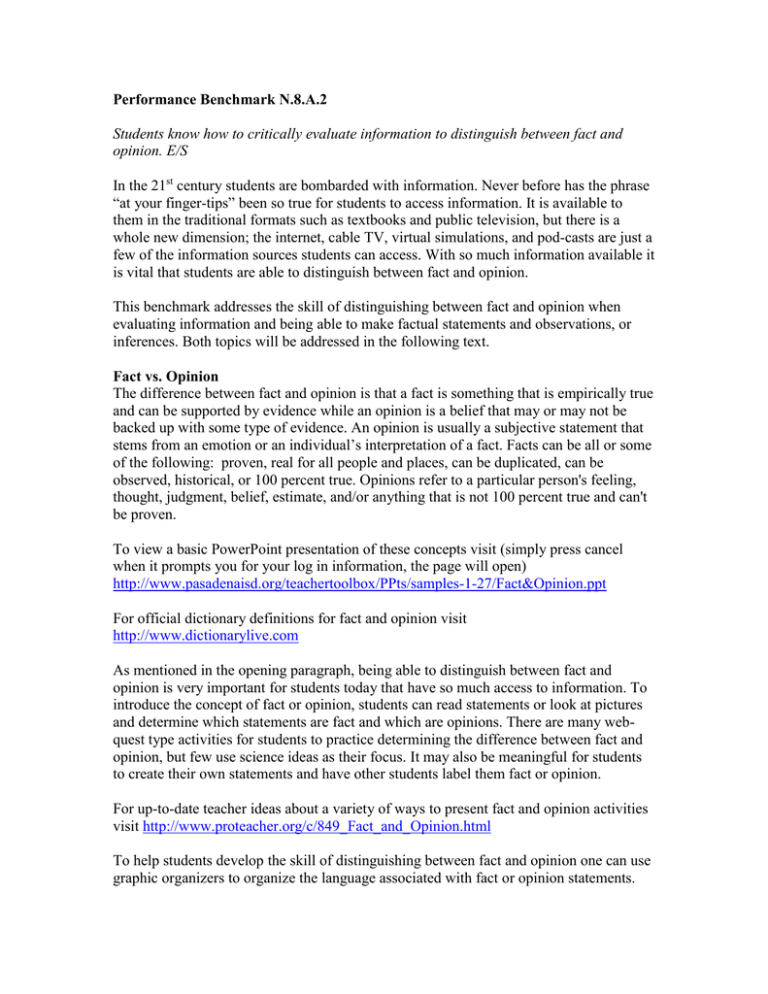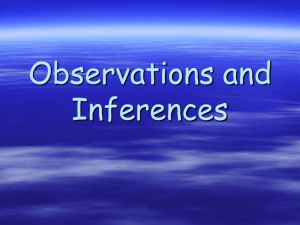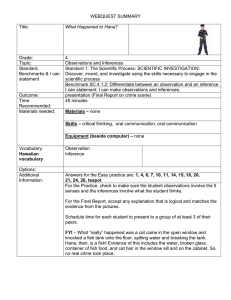Performance Benchmark N.8.A.2 opinion. E/S
advertisement

Performance Benchmark N.8.A.2 Students know how to critically evaluate information to distinguish between fact and opinion. E/S In the 21st century students are bombarded with information. Never before has the phrase “at your finger-tips” been so true for students to access information. It is available to them in the traditional formats such as textbooks and public television, but there is a whole new dimension; the internet, cable TV, virtual simulations, and pod-casts are just a few of the information sources students can access. With so much information available it is vital that students are able to distinguish between fact and opinion. This benchmark addresses the skill of distinguishing between fact and opinion when evaluating information and being able to make factual statements and observations, or inferences. Both topics will be addressed in the following text. Fact vs. Opinion The difference between fact and opinion is that a fact is something that is empirically true and can be supported by evidence while an opinion is a belief that may or may not be backed up with some type of evidence. An opinion is usually a subjective statement that stems from an emotion or an individual’s interpretation of a fact. Facts can be all or some of the following: proven, real for all people and places, can be duplicated, can be observed, historical, or 100 percent true. Opinions refer to a particular person's feeling, thought, judgment, belief, estimate, and/or anything that is not 100 percent true and can't be proven. To view a basic PowerPoint presentation of these concepts visit (simply press cancel when it prompts you for your log in information, the page will open) http://www.pasadenaisd.org/teachertoolbox/PPts/samples-1-27/Fact&Opinion.ppt For official dictionary definitions for fact and opinion visit http://www.dictionarylive.com As mentioned in the opening paragraph, being able to distinguish between fact and opinion is very important for students today that have so much access to information. To introduce the concept of fact or opinion, students can read statements or look at pictures and determine which statements are fact and which are opinions. There are many webquest type activities for students to practice determining the difference between fact and opinion, but few use science ideas as their focus. It may also be meaningful for students to create their own statements and have other students label them fact or opinion. For up-to-date teacher ideas about a variety of ways to present fact and opinion activities visit http://www.proteacher.org/c/849_Fact_and_Opinion.html To help students develop the skill of distinguishing between fact and opinion one can use graphic organizers to organize the language associated with fact or opinion statements. Fact terminology Many, exactly, precisely, actually, data, factual, justify, verify, proven, etc Opinion terminology Should, best, favorite, sometimes, belief, notion, idea, etc For independent study or assessment of fact and opinion visit http://www.bbc.co.uk/skillswise/words/reading/fact_and_opinion/quiz.shtml The Scientific Method Figure 3. Flow diagram showing the processes of the Scientific Method (From http://scifiles.larc.nasa.gov/text/kids/Research_Rack/tools/scientific_method.html) The scientific method is a process by which scientists construct a representation of the world. In education we use it as an educational tool to teach students scientific processes and organization. The purpose of this educational model is to minimize the influence of opinion or bias in the scientist when testing a hypothesis or a theory or when conducting an experiment. Recognizing that personal and cultural beliefs influence both our perceptions and our interpretations of natural phenomena, scientists aim through the use of standardized procedures and criteria to minimize those influences when conducting scientific experiments. It is included in this discussion about facts, opinions, observations, and inferences because a scientist actively seeks to minimize the tendency to include personal opinions. This is why communication, the final step of the Scientific method modeled above is probably the most important step. Communication is the key to good science. Peer review of the supposed facts and conclusions drawn by one scientist may be refuted or supported by another, but with out open communication this review would never happen. Observations and Inferences Every day we make inferences based on our observations. For example, if a student does not turn in their homework; they must not care about their grades. Understanding the difference between fact and opinion and being able identify both in scientific work sets the foundation for students to make their own factual statements in using science processes such as observing, inferring, predicting/hypothesizing, and concluding. Fact and opinion are independent of one another, but observations and inferences should have a causal relationship. Inferences are interpretations made from observations. These two skills, observation and inference, are used together in science. Scientists make inferences based on their observations to form conclusions. A direct observation is something that can be made with only the five senses (sight, touch, hear, taste, and smell), it is an awareness of something. Indirect observations can be made using tools that enhance the sense or ability to observe and record data. For example; microscopes, telescopes and cameras to enhance vision, microphones to detect sounds, and chemical detectors to “sniff” scents similar to the job the nose does. Inference involves a decision being made about something observed; it is mental process of explaining the observations and combining multiple observations to attempt to determine what will happen next or what may be the outcome of this event. The example below depicts a graphic organizer students created after examining this spherical-shaped object pictured below. Observations It has red spots It has yellow on it It feels rough It feels light It smells bad It doesn't make a sound unless Inferences I think it's a hacky sack It's used to play with It must be a ball It's a soccer ball It's a toy you move it It’s round It's squishy Figure 2. An example of a graphic organizer to categorize observations and inferences (From http://www.rockabrain.com/pages/lc_observation_inference.htm) For official definitions of observation and inference go to http://www.dictionarylive.com For a basic PowerPoint comparing observation and inference with an example visit http://science-class.net/PowerPoints/Observation_Inference_8th.ppt For activities to develop the skills of observation and inference see http://www.shodor.org/succeed/curriculum/FOR/observation.html For more activities to develop the skills of observation and inference visit http://www.science-class.net/NOS/observation.htm Bias Bias is a term used to describe a tendency or preference towards a particular perspective. A bias statement is based on one’s own beliefs or feelings rather than facts and proven theories. Bias is a natural human tendency, which is why the scientific community actively guards against and minimizes bias through open communication and the peer review process. It is important for students to be familiar with personal bias when reading or writing. The internet has provided a forum for anyone to display their ideas, opinions, and bias for millions to access without the scrutiny of a peer review. There are many peer-reviewed information sources that students can access. Teaching students the difference between peer-reviewed databases and general search engines is important for students to know. All CCSD students have access to EBSCO and GALE database providers. EBSCO host is a collection of school magazines, periodicals, newspapers, and topic searches for students to access. The information provided through this database has been peer-reviewed for accuracy. The GALEGROUP is a similar database to EBSCO focusing solely on science topics. These databases are excellent for students who are serious about science as they can help students to distinguish between someone simply posting an opinion on the internet and a peer-reviewed article. CCSD teachers and students can access the following tutorials and have full use of these databases, by visiting the following sites, http://search.ebscohost.com http://infotrac.galegroup.com (Username and passwords are often controlled by the school librarian in CCSD and can be obtained for teacher use.) In summary, the ability of a student to distinguish between fact and opinion is vital in this age of information. Once students are able to distinguish between the two it is logical to help them evaluate material for fact or opinion. Additionally it is important for students to be able to write factual material when reporting on their observations and making inferences. Performance Benchmark N.8.A.2 Students know how to critically evaluate information to distinguish between fact and opinion. E/S Common misconceptions associated with this benchmark 1. Students at the middle school level have a tendency to believe all information they hear or read. It happens all the time; students come into class to share what they heard or read last night. When you ask them where they got their information they say from a friend or online. They can rarely tell you the actual source of the information never mind the reliability of the source. It is important that students review a variety of information pieces to learn to distinguish facts from opinion. It is human nature to be gullible or naive, to believe without reason or evidence. They have not yet developed the advanced skills and sophistication to ask for evidence to support what is being claimed. As an educator it is important to be aware of this student tendency and consistently ask students to justify, support, and provide evidence in their science thinking. To read about teenage judgment and critical thinking skills visit http://www.eurekalert.org/pub_releases/2004-05/niom-iss051304.php http://atheism.about.com/od/aboutskepticism/p/Gullibility.htm 2. Students naturally make inferences; it is more difficult for them to make observations. Making observations seems like a simple task. However, the brain automatically tries to make connections between new information and existing information, and thus inferences are made. Teachers need to be aware that inferences come naturally to students, but they have to be taught how to observe. In the intervention strategies of this benchmark, activities are provided to help student develop the skill of observation. To access practice activities for students to distinguish between observation and inference visit http://science-class.net/NOS/observation.htm Performance Benchmark N.8.A.2 Students know how to critically evaluate information to distinguish between fact and opinion. E/S Sample Test Questions Questions and Answers to follow on a separate document Performance Benchmark N.8.A.2 Students know how to critically evaluate information to distinguish between fact and opinion. E/S Answers to Sample Test Questions Questions and Answers to follow on a separate document Performance Benchmark N.8.A.2 Students know how to critically evaluate information to distinguish between fact and opinion. E/S Intervention Strategies and Resources The following is a list of interventions strategies and resources that will facilitate student understanding of this benchmark. 1. Science Maniacs Music The Science Maniacs music is an exciting and innovative tool to teach important science processes. All songs are founded in the National Science Standards. The original CD addresses the following topics: scientific method, fact vs. opinion, the metric system, experimental design, ethics in science, and graphs. There are also lessons for each song. To access the music and lesson plans go to www.sciencemanaics.org http://cdbaby.com/cd/sciencemaniacs 2. How Observant Are You? This activity demonstrates our ability to remember details accurately. Testimony about personal experiences is frequently used during an investigation, and can even make or break a case. How accurately do people remember what they have seen? What factors may play a role in what we can remember and describe about something we have witnessed? Consider these questions as you do the following activity. To access this activity go to http://www.shodor.org/succeed/curriculum/FOR/observation.html 3. Fact/Opinion Quizzes Quia is a teacher webpage builder. You can access many teacher’s self-made activities and quizzes. This particular set of quizzes will allow independent practice distinguishing between fact and opinion. To access this quiz go to www.quia.com/pop/12709.html 4. Observation and Inference activities by Science-Class.net This website is a great resource for all science subject areas. This link will take you to a list of activities, labs, PowerPoint presentations, and quizzes for observation and inferences. To view these website go to www.science-class.net/NOS/observation.htm

